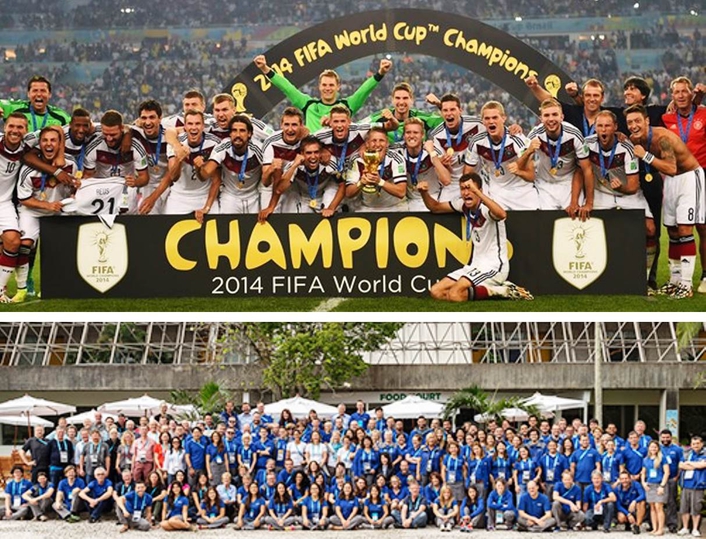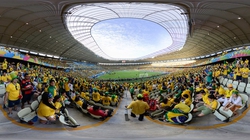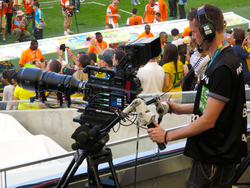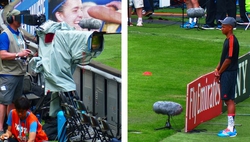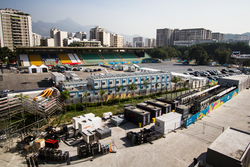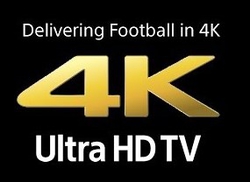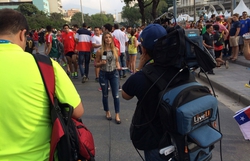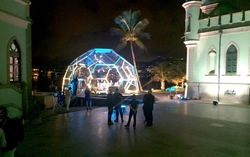2014 FIFA World Cup Brazil: The Champions - Germany & HBS
posted:
2014 FIFA World Cup Brazil - A Resounding Win for HBS
HBS celebrated its 15th anniversary this year and has now delivered the last four FIFA World Cups™ to great acclaim, with each of its host broadcasts building on the innovations and lessons of the previous one. HBS was responsible for the entire host broadcast operation at all twelve venues as well as at the International Broadcast Centre in Rio de Janeiro from which Media Rights Licensees (MRLs) sent their programming to their respective home countries.
Read more ...
FIFA World Cup Final Breaks Records for TV Broadcasters
Broadcasters have also been quick to grasp the opportunities provided by online distribution. Germany’s extraordinary semi-final victory over Brazil was watched online by a record 8.4 million fans across Europe and the Middle East including 2.35 million visitors on mobile platforms operated by broadcasters. And viewer engagement was up, with the same match generating a new record for any sports event of over 35m tweets.
Read more ...
advertisment
From Brazil to Russia
Today the eyes of the world are still on Brazil but with the curtains closing on what has been a truly memorable tournament, the focus will soon shift to 2018 when the biggest country in the world gets set to host football’s flagship event for the first time. The ceremony took place inside the iconic Maracana Stadium with FIFA President Blatter presenting a signed certificate to mark the hand-over from Brazil to Russia while Brazilian President Dilma Rousseff and President of the Russian Federation Vladimir Putin together received signed official Match Balls.
Read more ...
Why Germany Won & Argentina / Lionel Messi Lost the Final
One nation rejoiced while another mourned as Germany became the World Cup champion for the fourth time in its history after defeating Argentina 1-0 with an extra time goal from Mario Goetze in the 2014 FIFA World Cup Final Sunday in Brazil. Germany was very deserving of the trophy, but Argentina could have won this one. In fact, the winning goal was on an Argentinean foot quite a few times and each chance was blown. For example, Gonzalo Higuain got a chance most players would dream of in a final.
Read more ...
advertisment
Final Countdown in Brazil
Maracana Stadium in Rio has one more match to go before it closes out not only its 2014 World Cup experience but the entire event as it will be home to the ultimate showdown: the final between Argentina and Germany on July 13. With 63 football matches already played in 12 disperate venues in 12 disparate cities across a massive and beautiful nation that is still struggling, in many corners, to enter the third world, there were plenty of challenges for FIFA TV and HBS.
Read more ...
Attendance in FIFA’s Global Stadium Reaches 230 Million
FIFA’s Global Stadium is the social, online and mobile hub for the World Cup matches where fans can follow the games live and engage with friends, worldwide fans, players, coaches and celebrities. Football fans from every country in the world went through the virtual turnstiles to consume more than 7.5 billion page impressions of official World Cup digital content. FIFA’s mobile and social platforms contributed to the record-breaking crowds who engaged with FIFA’s digital platforms, with 79 million fans connecting to World Cup content on mobile devices as the final whistle blew on the USA-Germany game.
Read more ...
advertisment
FIFA World Cup Final to be Filmed in Pioneering 360° Ultra HD
Football fans will be able to re-live all the drama and emotion of the 13 July match between Germany and Argentina in this ground-breaking format for the first time at the new FIFA World Football Museum in Zürich, which is scheduled to open its doors to the public in early 2016. The innovation is the latest visual technology to be introduced by FIFA as part of the production of the FIFA World Cup in Brazil, alongside live 4K and 8K productions of matches and a multimedia revolution in sports entertainment.
Read more ...
FIFA TV and NHK: 8K Match Production
As a collaborative project NHK (Japan Broadcasting Corporation) and FIFA will co-host a series of live and recorded public viewings of nine matches in 8K Super Hi-Vision at the Sofitel Rio de Janeiro Copacabana (FIFA Official Hotel), CBPF (Centro Brasileiro de Pesquisas Fsicas) and the IBC SHV screen. NHK is travelling with its SHC-01 8K OBVan from Receife (Coast of Ivory – Japan), to Natal (Ghana – USA and Japan - Greece), to Brasilia (Cameron – Brazil) to Belo Horizonte (Chile – Brazil) back to Brasilia (France – Nigeria and one Quarter Final) further on again to Belo Horizonte for one Half Final and finally to Rio de Janeiro for the 2014 FIFA World Cup Final.
Read more ...
advertisment
4K Live Productions at Maracana Stadium
GloboSat’s new TV OB truck is producing three 4K live broadcasts from World Cup matches played in the Maracana stadium, in Rio de Janeiro: The round of 16 match on 28 June, the Quarter-Final on 4 July and the Final on 13 July. The vehicle, which was completed just in time for this year’s FIFA World Cup, is Brazil’s first 4K OB truck, and is fitted with audio equipment from Lawo and state-of-the-art RAVENNA IP networking technology. At the heart of the audio control room is a latest-generation 48-fader Lawo mc²56 – which is both compact and powerful.
Read more ...
Sony and Vue Unveil Live 4K Streamings of FIFA World Cup Matches to Cinema
Coinciding with rapidly growing consumer interest in 4K, the first ever 4K FIFA World Cup™ brings an entirely new viewing experience to the world of football and this screening is set to bring the action on the pitch to life like never before. The two matches will be streamed live via satellite from the iconic Estadio Jornalista Mario Filho (Maracana) stadium direct to the cinema, and are set to be the most visually spectacular live sports broadcasts to date. Sony has partnered with IDC, Eutelsat and DSAT Cinema to deliver the live 4K screenings.
Read more ...
advertisment
Globosat Kicks Off World Cup with Help from Ross Video
“Ross Video’s Furio Robotic Cameras are playing a leading role in production of shows from Globosat’s spectacular Glass Ball studio on Fiscal Island,” said Juan Carlos Ortolan, Ross Video’s Director of Sales for Latin America. “This studio is hosting SporTV channel’s primetime daily FIFA 2014 show, which is considered to be the most-important daily show of the World Cup.” The Furio Robotic Cameras are being used by Globosat for camera automation and to support data tracking for the augmented reality elements. A Ross Video Carbonite production switcher with a C2 panel is being used to run the show from the Glass Ball Studio while openGear is being used for sync generation, distribution and down conversion.
Read more ...
Bexel Scores with FIFA World Cup Games
With almost a third of the world’s population predicted to tune in to watch one or more of the FIFA World Cup soccer matches, the tournament has become one of the biggest international broadcasts of all time. So when the English speaking U.S. broadcast rights holders ESPN wanted to build temporary studio production facilities in Rio de Janeiro, they turned to Bexel, a unit of the Vitec Group’s Services Division and a leading worldwide provider of broadcast services and solutions. The original concept for the project when it launched in November 2012 was limited to a small flypack located near Copacabana beach.
Read more ...
advertisment
Vizrt Solutions Enhance TV Azteca’s World Cup Coverage
Four Viz Engine rendering and real-time compositing tools from Vizrt are being used to enhance TV Azteca’s graphics, as well as for integrated social media capabilities, including its popular “Tweet Wall.” With Viz Engine, social media data is easily integrated into the graphics workflow, using TV Azteca’s in-house data analysis harvest tool integrated with the Vizrt Social TV solution.
Read more ...
Making the Right Connections
When it comes to business, it’s good to have the right connections; when it comes to the Commentary Switching Centre (CSC), it’s essential. “We can prepare in advance all of the relevant connections for one match. Then, when we switch on this match, all of the connections are made at the same time, just like that,” explains Senior Engineering Manager Bernard Wright. Put simply, the CSC works in conjunction with the Booking department to take the MRL commentary position bookings and turn them into physical switch circuits – or, in other words, to connect them.
Read more ...
advertisment
Analysing the Analysts
Media Rights Licensees (MRLs) at the International Broadcast Centre (IBC) for the 2014 FIFA World Cup Brazil™ have a very powerful tool at their disposal: the Extended Basic International Feed (EBIF) Show, a ready-for-broadcast live programme. Aside from live coverage of the match, the EBIF Show provides MRLs with pre-match, half-time and post-match analysis from a team of experts: former England internationals Dean Ashton and Tony Dorigo, along with English FA Cup winner Matt Jackson.
Read more ...
Robotic Cameras at the FIFA World Cup Stadiums
Part of the 34-camera plan for each stadium was a tactical camera mounted on a GentleMote head very high behind the left goal, two BoxCams mounted in an elevated position in line with each goal, providing a clear view of the goal and its surroundings, two InGoal cameras positioned in the back top corner of the nets, providing a POV perspective inside of both goals, a BeautyCam providing a picturesque view from inside each stadium and finally the TunnelCam providing images of the gathering of the teams before they appear on the pitch.
Read more ...
advertisment
Fairlight Helps Germany Deliver Winning Coverage at the 2014 FIFA World Cup
Equipped with the very latest technology, ARD and ZDF's MPE uses a combination of Fairlight, Avid and EVS systems to create a networked environment that is capable of delivering exceptionally fast workflows without time-consuming format conversions. The Fairlight audio production system at the MPE consists of two Fairlight consoles, which are directly integrated into the high-turnaround HD video workflow based on content-management solutions from Avid Interplay® and EVS video servers.
Read more ...
Mark of Quality
With all the world watching the 2014 FIFA World Cup Brazil™ it is essential that all content meets the pre-determined standards and remains consistent across all content from match footage to interviews to features. That is where the staff of the Quality Control Room (QCR) come in. The QCR is located in the FIFA World Cup Production Centre. It serves as the central point for HBS' quality control and as the command centre of any audio and video content produced as part of the overal television production of the 2014 FIFA World Cup Brazil. A seperate QCR for the multimedia production is also located in the multimedia area of the Production Centre.
Read more ...
Surrounded by Sound
The great images of the FIFA World Cup™ might be what is imprinted in the mind of the viewer, but would they have as much meaning without the sound of sheer elation, or groans of despair, which accompany such moments? That is the job of the HBS audio team, led by Christian Gobbel, the Senior Engineering Manager, who believes “50 per cent of the enjoyment of a football match comes from the audio.” Which is why the audio teams at the IBC and those working at the 12 venues of the 2014 FIFA World Cup Brazil™ have a very simple task: to take viewers into the heart of the action by providing the crystal-clear soundtrack which brings an overall sense of being at the stadium.
Read more ...
Eye in the Sky
An 18-month project has culminated with seven helicopters, each with two sets of pilots who work on a 14-day shift pattern, taking to the skies of Brazil. Beginning 165 minutes before kick-off at each of the venues hosting matches on that particular day, the aerial cameras focus on team bus movements from their Venue Specific Team Hotels (VSTH) and their arrival at the stadium, as well as producing stunning aerial views of the 12 host cities of the 2014 FIFA World Cup Brazil™ during the pre-match coverage.
Read more ...
Sugarloaf Never Looked so Sweet
After the success of the Outside Presentation Studios at the 2010 FIFA World Cup South Africa™ FIFA and HBS, in partnership with the LOC, were eager to replicate the experience in Brazil by providing a limited number of studios with the best possible view. The problem was that the best view identified was from the end of Copacabana Beach on Avenida Atlantica, a main traffic artery in Rio's Zona Sul. HBS' solution was to construct the studios on top of a nine-metre high platform that would straddle the road and pavement, without affecting pedestrians and vehicles.
Read more ...
Countdown to Kick-Off
For the 2014 FIFA World Cup Brazil™, HBS has increased the MD-1 coverage to include one feed per active MD-1 venue and eight cameras per venue. From the Quarter-Finals onwards the number of cameras will increase to 13, with CableCam, Super Slow Motion (SSM) and Ultra Motion (UM) among the additional cameras. MD-1 live content can be viewed at the IBC through a dedicated router service booked by MRLs, while highlights with cut-down coverage of the press conferences, interviews and training are also produced for broadcast and multimedia use.
Read more ...
Keeping Things Under Control
Despite all the screens showing the matches there is little time to enjoy the finer points of the FIFA World Cup™ action when you are working in the Production Control Room (PCR). Instead the focus is on overseeing the distribution of incoming and outgoing feeds as well as ensuring the smooth flow of material exchange inside the IBC.
Read more ...
World Cup is the Global Test of 4K Streaming
The FIFA World Cup runs through July 13 and millions of people around the globe will stream the games, highlights and even replays over the Internet. Cisco, Sony, Akamai and anyone who is anyone in the content production, distribution and delivery food chain will be watching with extreme interest … just to see how well the global Internet performs. It was widely discussed at the recent BroadbandTV conference because the IP broadcast of the event should generate more than 4.3EB. That’s about 3X the monthly IP traffic generated by Brazil (an Exabyte is 1,000,000,000,000,000,000 Bytes and the volume generated will be roughly equal to all of the words ever spoken by humans).
Read more ...
Let the Football Carnival Begin
The 2,417 days since Brazil were awarded the 2014 FIFA World Cup™ have passed, all the years of preparation, planning and fine-tuning by HBS, FIFA and the LOC come down to this moment as the tournament begins with the Opening Match between Brazil and Croatia. The International Broadcast Centre (IBC) is alive with activity as broadcasters prepare to share the first moments of the month-long carnival of football with their audiences. With kick-off just hours away everyone at the IBC is ready and prepared to deliver.
Read more ...
Equipment Room Containers Arrive Across Brazil
Pre-assembled and tested in Germany at the systems integrator sonoVTS, the ERC is the hub of all onsite outside broadcast operations at each Broadcast Compound around Brazil, connecting to all operational rooms. The full testing of the facility before it arrived in Brazil saved countless valuable hours for staff at the venues. Once testing was finished the cables and equipment were carefully packed away and shipped across the Atlantic Ocean, ready to be delivered to all 12 cities hosting FIFA World Cup™ matches – a process that has been taking place across all venues in the past week.
Read more ...
ARD/ZDF World Cup Studio Uses Lawo V__link4
German national public broadcasters ARD and ZDF have been relaying live coverage from Brazil since 12 June. Accompanying TV pictures from the rooftop World Cup studio at the Copacabana are shared by both channels, and offer stunning views across Rio de Janeiro with the beach and landscape in the background. For the first time, the broadcast is being handled without an OB van on-site; instead, the entire studio delivers remote production to the main studio control room in the International Broadcast Center (IBC) 35 km away.
Read more ...
Over 200 units, 80 Broadcasters, 2,662 Hours of Live Transmission
LiveU, a leader in portable live video acquisition, contribution and management solutions, has announced that more than 80 broadcasters from around the world have used its technology during the 20th FIFA World Cup in Brazil, bringing the event to life and providing 360 degree coverage that would otherwise be impossible. Broadcasters are choosing to transmit the vast majority of their LiveU footage live: a remarkable 98 per cent of the 10,156 transmission sessions were made using live transmission mode. This represents a major increase from the last game-changing event for cellular bonding: the London 2012 Olympics. With over 200 LiveU units deployed, 2,664 hours of live transmission, and over 40.2TB of data delivered, the tournament is proving highly successful for those using LiveU.
Read more ...
Euro Media Group Delivered Coverage of FIFA World Cup 2014 in Brazil
During the tournament over 120 crew from Euro Media Group companies have supplied the television coverage of matches from Natal, Recife and Rio de Janeiro as well as aerial coverage of all 12 host cities. In total, crew from CTV, Euro MediaFrance, United and Videohouse have deployed more than 60 Sony cameras for the production of the international signal for 16 matches, including a quarter-final and the final. DVS supplied super slow motion shots with 8 engineers, over 36 games, deploying two Superloupe for each match for HBS. ACS (Aerial Camera System) provided all aerial coverage of the tournament for the Host Broadcasters. The Aerial Unit’s team of 23 crew and 28 pilots completed over 500 flying hours throughout the World Cup. United, the Group’s Dutch subsidiary, also produced graphics for various channels (NOS, VRT, RTBF).
AMP VISUAL TV is Off to Brazil to Help Broadcast the 2014 FIFA World Cup
As a broadcasting partner to Host Broadcast Services (HBS) for the 2014 FIFA World Cup, Sony is responsible for covering all of the HD needs for each of the Brazilian sites. HBS and Sony took great care when choosing their service providers from a selection of the very best, and AMP VISUAL TV was chosen for the quality of its equipment and teams, and its track record at major events. AMP VISUAL TV will cover broadcasts from cluster D, a grouping that will see twenty matches, including a semi-final, played in three stadiums: Sao Paulo, Porto Alegre and Fortaleza. The company responsible for this cluster will be involved in the very first moments of the tournament, moving from the opening ceremony to the first match in just a few seconds (with a complex equipment change). The cluster will be managed by two French directors: Jean-Jacques Amselem and François Lanaud.
Read more ...
Mediapro Brings its World Cup Coverage to an End
Mediapro provided broadcast services for a host of TV stations including: beIN Sport (full HD), Argentine public TV, Fox, ESPN and Gol Televisión, which saw José Sanchís, Axel Torres, Joan Capdevila, Jordi Domínguez, Ricardo Rosety and Carolina García bringing viewers all the latest news from Brazil. Technical highlights included the raised stage on the beach in Rio using the new Rosco View system which allows users to control the external light entering the studio and the studio bus rigged up with a regie system and 3 cameras and satellite transmission for Argentine public TV and Fox. A 100-strong team from Mediapro Brazil were based in the RFEF facilities in Curitiba. The city hosted all the non-sporting services for the Spanish team such as the Mediacenter for 125 journalists, 30 camera stands, radio and TV studios, training ground technical equipment (lights, equipment for media outlets) Internet services and streaming (100MB in the Mediacenter and 50 MB for Spanish TV stations to be streamed into the players’ rooms), electrical equipment, generators and safety equipment.
Read more ...
Globosat Kicked Off World Cup with Help from Ross Video
Ross Video announced that Globosat is using Ross Video products to deliver exciting, high-quality coverage of the 2014 World Cup. Launched in 1991, Globosat leads the Brazilian pay TV market and has 33 channels and more than 1,800 employees. Globosat delivers entertainment, information, and leisure programming via channels including Rede Telecine, SporTV, GNT, Multishow, Globonews, Viva, Gloob, +Globosat, Universal Channel and Canal Brazil.
Read more ...
Artemis Consoles Used to Create Full Mixes in 5.1 and Stereo Simultaneously
At the International Broadcast Centre (IBC) in Rio de Janeiro, two 24-fader Artemis Light consoles served as the first point of control in the signal path, responsible for submixing all sound associated with the matches and creating simultaneous 5.1 and stereo mixes. In addition, controlled commentary and controlled effects were passed on to all other users including the edit suits in the IBC, the various multiplatform control suites in the U.K., and the BBC's studio broadcasting center (SBC), also in Rio. At the SBC, a 56-fader Artemis Beam was used to combine the submixes from the IBC with other sources, including studio mics, postproduction playbacks, contributions from venue reporters/presenters, and audio-only playback such as music, sound effects, and voice recordings. These were all mixed into final 5.1 and stereo feeds and then passed on to the transmission network in the U.K.
Read more ...


